Matador Network's Blog, page 25
July 17, 2025
Aruba, Fiji, and Paros Topped Expedia’s First-Ever Island Hot List. Here’s Why.

As international travel continues to rebound, one type of trip is emerging as a popular favorite: island vacations. On July 15, one of the world’s biggest booking websites released its first-ever “Island Hot List,” ranking the most popular islands in the world based on the last 12 months of travel. According to Expedia, interest in island destinations has surged by more than 30 percent globally compared to last year. Its rankings reflect not just the most postcard-perfect beaches in the world, but also show travelers’ priorities shifting toward sustainable tourism, cultural immersion, and off-peak travel.
Expedia’s 2025 Island Hot List is determined by in-depth analysis. The Expedia team reviewed more than one million accommodation searches from May 2024 to May 2025 and compared them to the same period the previous year, finding a 30 percent rise in interest in islands. Analysts also looked at average daily hotel rates during the peak season, ranging from approximately $150 in Bali to $655 in the Maldives, and compared the differences to off-peak periods. Other factors given weighted value include the number and frequency of flights, accommodation quality based on verified guest reviews, weather, cultural offerings, and recreation opportunities. It also used proprietary data from travelers, such as booking window lengths and specific search filters used, to see how trends had changed year to year.
According to the Hot List, these are the top beaches to visit in the next year.

Photo: Expedia Island Hot List
Aruba: Best for consistent weather

Photo: fokke baarssen/Shutterstock
Sitting just outside the hurricane belt, Aruba is a reliable pick for travelers who want near-guaranteed sunshine with minimal risks of storms and grey skies. It has a fairly dry climate that stays that way through the wet season, which gives travelers more flexibility for when to visit. In what would normally be a shoulder-season month, such as September, temperatures are still in the mid-80s, though hotel costs drop. Diving is a big draw, though visitors also tend to explore the island’s more rugged eastern coast on guided 4×4 excursions. Inland, Arikok National Park has cactus-lined trails and cave art preserved in limestone.
Bali’s reputation continues to spread beyond its yoga and surf-town draws. Expedia reports that the Indonesian island is seeing a sharp rise in demand for wellness-focused experiences, particularly in Ubud and the inland highlands. While yoga and plant-based cuisine now rank among the island’s most searched experiences, it’s also ranking higher for sustainable experiences. Bali has local bans on single-use plastics and incentives for resorts to adopt renewable energy and gray-water systems. Travel in Bali is generally most affordable during the drier shoulder season (from roughly September to November), when rainfall is low and the humidity is slightly more manageable.
Dominican Republic: Best for outdoor adventure

Hiking El Salto Del Limón in Samana, Dominican Republic. Photo: B Cruz/Shutterstock
The inclusion of the Dominican Republic suggests a growing interest in Caribbean destinations that blend classic beach escapes with more adventurous exploration. While Punta Cana, home of dozens of all-inclusive resorts, continues to attract beachgoers, Expedia’s search data shows a growing interest in less touristed parts of the country, including Jarabacoa and Constanza. Those regions draw travelers with hikes to waterfalls, guided canyoning tours, and national parks like Armando Bermúdez. Per the report, April is a particularly good time to visit, when rainfall is low and adventure outfitters offer seasonal discounts. Cultural travelers will want to spend a few days in Santo Domingo, with its preserved colonial quarter and booming culinary scene.
The Maldives remains one of the most iconic destinations for honeymoons and anniversary trips. While its overwater villas and turquoise lagoons are well known, the island nation has taken tangible steps to reduce tourism’s ecological impact. These include mandating coral restoration work at new developments and requiring resorts to participate in marine conservation education. Travelers seeking better value often book during the shoulder month of May, when rainfall is sporadic but visibility remains excellent for diving and snorkeling.
Fiji: Best for community-based travel

Photo: ChameleonsEye/Shutterstock
Fiji’s position on the list highlights a push toward regenerative travel. The country has multiple government policies and programs designed to ensure tourism benefits local communities, including coral reef restoration programs, cultural exchanges in remote villages, and tree-planting programs funded by tourism taxes. Search volume for Fiji rose substantially between 2024 and 2025, according to the report, especially with travelers from Australia, New Zealand, and the West Coast of the US. September and October are ideal for those looking to avoid the rainy season while still enjoying lower-than-peak airfare and hotel rates.
Jamaica’s appeal has always been cultural as much as coastal, even if it’s known for sprawling beachside resorts. From Rastafarian communities in the Blue Mountains to historic plantations and street-level food tours in Kingston, the island offers plenty beyond the beach. According to the data, most the interest is outside resort zones like Montego Bay. December was flagged as one of the best months to visit, when rainfall tapers off and music festivals ramp up — though Carnival in February is a lively time, too.
Sardinia, Italy: Best for culinary exploration

Photo: BOOCYS/Shutterstock
The fact that Sardinia is a trending destination may suggest a growing curiosity about Blue Zones, or the regions around the world where people live significantly longer than average. In addition to its reputation for healthy Mediterranean cuisine, travelers are also showing interest in agrotourism and village markets. Food-forward travelers are seeking out farm-stay experiences where they can sample unique sheeps’ milk cheeses, roasted meats, and local wines. September is again the recommended month to visit, according to data, when harvest festivals begin and temperatures remain beach-friendly.
O‘ahu is the only US island on the list, showing that when it comes to domestic destinations, travelers are opting for both natural beauty and cultural depth. According to the Expedia data, surf culture and native Hawaiian experiences are among the most searched themes related to the island. While Waikiki is a great base for a few days, travelers with more time to spare are trending toward North Shore villages and historic sites. September is a strategic time to visit, before winter swells bring in crowds and airfare spikes.
Paros, Greece: Best for nightlife

Photo: Pit Stock/Shutterstock
You may be familiar with Greek islands like Santorini, Mykonos, and Corfu, but Expedia’s data says it’s the island of Paros in-the-know travelers are heading toward. Searches for Paros were up 45 percent, and the report praises the island’s “rising design scene, low-key luxury stays, and its charming port towns.” It’s also more affordable and less-crowded than the aforementioned tried-and-true islands. It’s easy to reach via quick connecting flights or a water shuttle from Athens. The town of Naoussa is generally the best place to stay for nightlife and beach access, though it can be a little pricier than the capital city of Parikia.
The Maldives took the top spot for romance, but the trade-off is that those romantic over-the-water bungalows are usually at least $1,000 per night. But Expedia’s data found that travelers seeking luxury stays without upper-echelon price tags are increasingly turning to Thailand’s Koh Samui. The island is becoming known for yoga retreats, detox program, and general wellness and spirituality, though it’s also a top destination for diving and beaches. Interest in the island was up a stunning 55 percent, though that’s probably in part due to Season Three of the White Lotus, which filmed at a luxury Koh Samui resort.
The full list of the top trending islands, including tips for saving on beach travel, is available on the full Expedia Island Hot List announcement. 
Almost Heaven, Indeed: Where to Go in West Virginia By Traveler Type

“The biggest misconception about West Virginia is that there’s nothing to do here,” says Lindsey Funk, lifelong resident and Public Relations Assistant at the West Virginia Department of Tourism. After spending four action-packed days in just three of the state’s 55 counties, I can declare that myth officially busted. From heart-pumping outdoor adventures to a vibrant arts and culture scene to elevated cuisine crafted by a James Beard award-winning executive chef, there’s something here to delight nearly every type of traveler.
For outdoor adventurers: New River Gorge
Photo: ACE Adventure Resort
The New River Gorge region — located about an hour south of Charleston, the state capital — is a sure bet for nature and adrenaline lovers alike. Its namesake national park and preserve encompasses more than 70,000 acres of dense hardwood forest and 53 miles of river, presenting visitors with ample opportunity for rafting, hiking, climbing, mountain biking, and more — all set against the backdrop of a stunning natural landscape.
My visit finds me clad in a wetsuit, bumbling down a mountain road in an old school bus, listening intently to a crash course on how not to drown from a whitewater rafting guide with ACE Adventure Resort. “If you spit in it, it’ll be over the limit,” he says, describing the rain-induced high water levels of the Lower New, a section of the New River Gorge that’s known for its challenging rapids.
Any second thoughts I have dissolve the moment we push off the rocky shore. I’m surrounded by 1,000-foot cliffs, paddling along the gently (for now) rolling water of an ancient river, under the captainship of an experienced professional whom I trust wants us to have the time of our lives as much as he wants us to not drown.
As the river gets wilder and wilder, my smile gets bigger and bigger. My boatmates and I have become a fearless team, tackling Class IV and V rapids with swelling confidence and a fair amount of swearing. We smash gleefully into churning chunks of river with names like Railroad and Greyhound, even managing to catch what the locals call “the million-dollar wave” — a standing wave in the Fayette Station Rapid that can reach up to 18 feet from its highest to lowest point. When our roughly 10-mile trek comes to an end, the only reason I agree to get out of the boat is to relieve my aching arms.

Photo: ACE Adventure Resort
A fierce afternoon thunderstorm puts the kibosh on my ziplining excursion. Although slightly disappointing, this gives me the opportunity to relax in my cabin on the grounds of ACE Adventure Resort. Rustic yet chic, this two-bedroom bungalow has all the comforts of home — including a private hot tub on a covered deck facing the woods. Almost heaven, indeed.
The resort also has a variety of other lodging options, ranging from spacious log homes that can accommodate as many as 18 people to basic tent campsites and budget-friendly bunkhouses. There’s a restaurant and bar on the property, as well as a general store, gear rental outlet, and even a full-blown waterpark. And because ACE can arrange all your New River Gorge adventures, you never need to leave the property if you don’t want to. It’s a great option for families, groups of friends, and solo travelers alike.
For history buffs: Fayetteville and Beckley
Photos: Anne Richard/Shutterstock and Allison Savage Bates
About 10 minutes north of ACE, you’ll find Fayetteville, which has a population of roughly 2,800. Forged by booms in the timber, coal, and railroad industries and steeped in Civil War history, the town now boasts a string of eclectic boutiques and diverse eateries.
When it’s time for happy hour, I step into Rosa’s Speakeasy — a delightfully quirky haunt located inside the historic Morris Harvey House Inn. It’s billed as “an intimate, curated craft cocktail experience set in a period-appropriate, historic Queen Anne Victorian,” and it delivers in spades. Nearly every nook and cranny is festooned with antiques and old family portraits (no relation to the couple that runs the inn), and the parlor echoes with the drowsy, intoxicating melodies of a bygone era. I order a “Puttin’ on My Tophat” — a zesty mix of mezcal, Ancho Reyes, apricot, pistachio, ginger, and lime — and wander the small cluster of rooms, imagining the stories these walls could tell.
Over in nearby Beckley, the Exhibition Coal Mine is a can’t-miss attraction for anyone interested in learning about West Virginia’s complicated industrial past. Coal from the Mountain State played a critical role in our nation’s rise to economic and military power in the 20th century. From 1927 to 1973, West Virginia produced more coal than any other state, and today, it’s second only to Wyoming in coal production.
Yet all that growth and prosperity came at a devastatingly high cost. It’s estimated that more than 21,000 miners have lost their lives in West Virginia coal mines since they began recording fatalities in 1883, and countless more have been injured and/or diagnosed with a debilitating respiratory disease known as Black Lung.
“Us coal miners would always eat dessert first,” says Mike, a former miner, current Black Lung patient, and tour guide at Exhibition Coal Mine, “because we never knew if we’d get out alive.”
Tours at the mine take you underground for a firsthand look at the hazardous conditions workers faced every day, led by retired miners who lived to tell about it. It’s an emotional and eye-opening experience I can’t recommend highly enough.
For culture hounds: Charleston
Photos: Allison Savage Bates
I’m not exactly sure what my expectations were for West Virginia, but I know they didn’t include national sporting events, world-class restaurants, and a devotion to community development that rivals that of even the most progressive global cities.
On this gorgeously mild morning in mid-May, I’m on a walking tour of the capital city’s downtown led by Tim Brady, President and CEO of the Charleston Area Convention and Visitors Bureau. We begin on a bridge overlooking the Kanahwa River, and the area is bustling with preparations for the upcoming USA Cycling Pro Road National Championships — an elite competition that generated $4.6 million in economic impact for the city last year.
We stroll a few blocks past independent book shops and vivid street art to City Center at Slack Plaza, a former transit mall whose recent transformation, Brady says, perfectly parallels that of the city.
“This used to be the bus stop,” he says, “and I won’t sugarcoat it: there was crime and drug activity, the surrounding buildings were mostly vacant, and nobody wanted to walk through here, even during the day.”
The space underwent a multimillion-dollar renovation and reopened in 2022 as a family-friendly gathering spot complete with public art installations, a splash pad for kids, and an outdoor stage for free summer concerts.
“This tells a story about Charleston that’s very important and dear to my heart,” says Brady. “And that is: if you put your mind to it, you can transform a place into something better for your community and more appealing to visitors.”
We end our tour at Capitol Market, where dozens of carefully vetted indoor and outdoor vendors sell everything from flowers and vegetables to fish and wine. Much of the market’s wares end up in the kitchen and on the plates at local restaurants, including 1010 Bridge — West Virginia’s first James Beard Award-winning restaurant, led by Executive Chef Paul Smith. A self-proclaimed “Appalachian New Americana” restaurant, 1010 Bridge is one meal you won’t want to miss in West Virginia, with menu items like zucchini crisps with herb peppercorn dressing, fried “Nashville hot” oysters, and an elevated take on chicken and waffles made with a ramp waffle, collard greens, maple barbecue, and spiced pot liquor.
Bottom line: Forget what you think you know about West Virginia and just goBeyond the natural, cultural, and gastronomical surprises I enjoyed in my brief time here, West Virginia has left on me an indelible mark, penned by the friendly faces of proud and resilient people eager to welcome you to their little slice of Almost Heaven. It’s wild, it’s wonderful, and it can’t wait to welcome you home on its country roads. 
No American City Fuels Summer Nostalgia Quite Like Chicago

I’ve lived a lot of lives in Chicago. The college years were dizzy with possibilities — lakefront walks, oversized slices, and friendships forged under skyline sunsets. But there’s something different about returning in my 30s. I still know the rhythm of the “L” and the curve of the lake, but now I can afford the cocktails.
Just so you know, Matador may collect a small commission from the links on this page if you decide to book a stay.
This June, I flew in for a long weekend with my cousin, chasing that electric feeling only a Chicago summer can deliver — the kind where you blink and suddenly it’s golden hour, everyone’s outside, and the city feels like one big block party. Upon arrival, we checked into Hotel Lincoln, a JdV by Hyatt property that sits just across from the park it’s named for, where vintage charm meets lake breeze in the best possible way.
It felt like the neighborhood version of the friend who always knows about the pop-up before it’s cool. The lobby was eclectic — gallery wall meets grandma’s attic meets local dive bar — and the energy was immediate: easy, welcoming, and local. From our window, you could see boats floating Lake Michigan, joggers weaving through the park, and families out with strollers and iced coffees, everyone trying to soak up the season before it slips away again. It was the perfect location for my morning walks and evening runs.
 Photo: Booking.com
Photo: Booking.com Photo: Booking.com
Photo: Booking.comOur days started with coffee from Elaine’s Coffee Call, and then we’d set out, unhurried. I’d forgotten how walkable Lincoln Park is — tree-lined streets, boutiques that make you want to redecorate your whole apartment, and restaurants where every patio table looks like a postcard.
I kept telling my cousin, “I could live here again,” as I daydreamed about what returning to Chicago could look like. We spent one afternoon at Batter & Berries, a Black-owned brunch spot I’ve loved since my student days, where the French Toast flight still ruins me for all other breakfasts. But this time, I wasn’t eating in a rush between classes — I was there fully present and grateful
From street food to skyline views
Photo: RomanSlavik.com /Shutterstock
Saturday was a full immersion into Summertime Chi, that brief, glittering window when Chicago shows off. We made our way to the Taste of Randolph Festival in the West Loop — an open-air celebration of food, music, and everyone’s best outfits. I lost count of how many cuisines we tried.
There’s a wild joy in eating standing up while a DJ spins nearby, in finding rhythm in a stranger’s playlist, in sweating through your outfit because the vibe is too good to leave. We took our time wandering, then grabbed a rideshare back downtown to check into our next location, the Chicago Athletic Association Hotel — where walking into the building is like opening a time capsule.
Marble staircases, dark wood walls, and leather lounges that whisper of stories from another era. Once a men’s athletic club in the 1800s, it’s now a moody, seductive hotel in the Unbound Collection by Hyatt, and stepping inside feels like entering a speakeasy you’re lucky to know about. But don’t mistake history for stuffiness. The CAA is alive. We played in the Game Room, sipped cute pink drinks under globe lights, and took in the city from Cindy’s Rooftop, where you can see all of Millennium Park stretch out in front of you. It was sunset again, the second of the trip, and somehow just as magical as the first — the kind of view that makes you put your phone down and just feel it.
 Photo: Booking.com
Photo: Booking.com Photo: Booking.com
Photo: Booking.comOur last day was slow on purpose. We walked the Chicago Riverwalk, grabbed sweets from Justice of the Pies, and later made our way to Bronzeville Winery, a Black-owned restaurant and wine bar that feels like both a celebration and a sanctuary. These are places that tell stories through food, design, and energy — they aren’t tourist stops, they’re part of the city’s heartbeat. What I love about Chicago is that it knows how to hold contrast. Grit and glam. High rises and hole-in-the-wall gems. A rooftop with a $17 cocktail and a block party with a $5 slice that tastes just as good.
That duality played out in the two hotels we called home for our trip. Hotel Lincoln gave us the warm, artsy welcome — a neighborhood stay with stories around every corner. Chicago Athletic Association gave us the cinematic finish — grandeur, history, and a view that makes you understand why people fall in love here. It’s easy to romanticize a city in the summer. But Chicago? It doesn’t need rose-colored glasses. It’s already turning its face toward the sun, pouring a drink, and dancing in the street. And if you’re lucky enough to be there — really there— you’ll feel it. Every time I come back, the essence of Chicago finds me — like no time has passed at all. 
July 16, 2025
Where to Play, Eat, and Stay in Winston-Salem, North Carolina

Cigarette machines used to be in nearly every bar and restaurant across the US, but now they’re obsolete. In Winston-Salem, many have become Art-o-mat machines, based on Clark Whittington’s original art installation in 1997. (Whittington is a Winston-Salem native.) Today, these machines are installed all across the country and sell about 100,000 small $5 art pieces per year. Artists earn half. I first encountered one in Las Vegas a few years ago and was delighted to visit the town where they originated.
It turns out that Winston-Salem is its own kind of Art-o-mat: renovated after the era of tobacco-industry dominance and refocused on art and history. From the University of North Carolina School of the Arts to the Sawtooth School for Visual Arts, the town is saturated with creativity, artistic displays, and subsidized studio spaces. Winston-Salem is also full of great food, gorgeous green spaces, and a mellow vibe worthy of a visit.
Even getting there is a part of the fun, thanks to the relaxing Piedmont Triad International Airport (GSO) in Greensboro, which is about 30 minutes away, full of rocking chairs, and has affordable nonstop service to Chicago and other East Coast hubs.
Things to do in Winston-Salem
Single Brother’s House. Photo: Quinn Kampschroer/Shutterstock
There’s a lot of history in Winston-Salem, and it’s on display throughout the city. I was dying to know how the city got two names, so let’s start there.
Winston-Salem’s name traces to the Moravians, members of a Christian religious group that still exists today. Moravians came from Europe to found Salem, North Carolina, in 1766. They created a thriving community (with the labor of enslaved people), and the town of Winston grew alongside them to provide goods and services that their religious beliefs wouldn’t allow. Eventually, Winston-Salem became one city with two names.
Old Salem is the place to learn about Moravians. It’s a living history museum that features preserved buildings, museums, and gardens that offer a glimpse into 18th- and 19th-century life, with costumed interpreters demonstrating traditional crafts and daily activities. A ticket to Old Salem includes admission to more than a dozen interpreted buildings and gardens, such as the Single Brothers’ House, where boys moved in at age 14 to learn a trade among the men.
The only way to move out was to marry or die, but before marrying, God had to approve the proposal via “the lot.” To know his will, one had to choose a paper from a vessel, and the only possible answers were yes, no, and blank — to be decided later. Girls also lived in a Single Sisters’ House, and though they had to wait until a man proposed to respond to a (pre-approved) request for marriage, they could decide against it, and the “no” was respected. Some chose never to marry and to stay with their sisters or brothers. Productivity, it seems, was more important to the community than family — though most did marry.
Also in Old Salem is the Museum of Early Southern Decorative Arts (MESDA), which showcases one of the largest collections of Southern decorative arts in the country. It’s worth a visit if you’re interested in period furnishings, guns, pottery, and the like. I’m always interested in how historical museums orient their collections, and this one is focused on European settlers. After all, the period showcased included Native Americans and enslaved people; it’s a curatorial choice to omit depictions of their daily lives. Additionally, though the Moravian Church evolved toward abolitionism and eventually apologized and sought reconciliation for its role as enslavers, the museum depicts none of this history through artifacts or stories.

Reynolda Hall at Hearn Plaza. Photo: Bryan Pollard/Shutterstock
If you need a bite while touring Old Salem, the Winkler Bakery is the country’s oldest continually operating bakery. It was founded in 1807 when a baker by the name of Christian Winkler took over a bakery that the Moravian Church built in 1799. It’s a fun historical stop, but the goods are more of a novelty than a flavor sensation — there are better pastries in Winston-Salem.
Across town from Old Salem, Reynolda Village and Reynolda House present another fantastic way to spend a day — and, really, I mean the whole day. This 1,067-acre estate was developed between 1912 and 1917 by RJ Reynolds and his wife, Katharine, of tobacco fame. The family home is now an American Art Museum, and the adjacent village has shopping and dining. The meticulously groomed botanical garden is free and open to the public. The whole grounds (minus the museum) are now owned by Wake Forest University. A footbridge connects the estate grounds; the presence of students in the gardens and shops is palpable and pleasant.
The village facilities were not only modeled after an English village — including a dairy barn, cattle shed, school, post office, smokehouse, blacksmith, etc. — but Mrs. Reynolds also had the village built with the same quality materials as the main house, creating a sturdy and lasting impression of how the estate might’ve looked. The restoration of the village has won awards and is listed on the National Register of Historic Places. Reynolda House is an intimately presented museum of American Art inside a historic house. Exhibits shed light on the complexities of the Reynolds’ legacy, as well. If you’re around in August, you could catch the soon-to-open Camel City: Tobacco & Transformation, 1875-1964, which highlights worker exploitation and the role of Black women in advocating fairness and trade unions.

Innovation Quarter and Sawtooth Center for the Visual Arts. Photos: Kimberly Dark
Continuing with the theme of renovation, downtown Winston-Salem has some great examples. What happens when large companies like Reynolds and Hanes (think socks and briefs) shut down US operations and move them abroad? Urban blight is the answer — but luckily not the end of the story in this case. The city’s Downtown Arts District is fun, and visitors can take a self-guided walking tour. The Sawtooth Center for the Visual Arts has fantastic facilities, and the building (a former Hanes factory) houses other arts organizations and theaters, too. Facilities include studios and instruction in woodworking, stained glass, metal, ceramics, and more. The gift shop and gallery spaces are free to the public and worth a visit to take home some authentic Winston-Salem creations.
The city’s Innovation Quarter also charmed me. The area is filled with repurposed factories serving gorgeous food and cocktails surrounding Bailey Park, where free films are shown on the lawn for relaxing picnics in the waning light of day.
Where to eat in Winston-Salem
600 Degrees. Photos: Kimberly Dark
Starting with Innovation Quarter, 600 Degrees is not to be missed. Both the alcoholic and alcohol-free cocktails were innovative and delicious. We tried a variety of small plates for dinner, including the hearth-roasted squash and queso, sweet potato and chickpea fritters, and tuna crudo. The Lil’ Drunken Key Lime Cake was delicious, and the service was superb.
Just a few blocks away, The Katharine Brasserie & Bar (yes, named for Mrs. Reynolds) provided a delightful downtown repast. We started with a charcuterie board worthy of its French origins, complete with three fruit compotes. The banana croissant bread pudding at the end of the meal was superlative.
For Southern fare, try Mozelle’s, where the tomato pie reigns supreme, and its accompanying succotash is a stunner. The Brussels sprout appetizer was a seared delight, and the coconut pie is almost too much at the end of a meal, but it makes for a rich treat back in your hotel room. Mozelle’s menu includes a list of farms from which the meal is locally sourced.
Now that you have dinner plans in order, let me recommend a Winston-Salem cocktail bar that serves as both entertainment and tipple. EasyTalk was founded by and is tended by artists. My bartender’s name was David, and I can see why he recently won a North Carolina bartender of the year award. EasyTalk is two bars in one. Downstairs is “easy,” with a clever menu of complex and delicious cocktails. Upstairs, you have to “talk” to get a drink — and it’ll be something that suits you in a unique way. My partner and I tried the first two ordering options. After a brief interview, David made me something like a Bluebird (a gin or vodka cocktail made with Blue Curacao), perfect for my palate. My partner rolled the dice to reveal a randomized selection, which yielded one of the best drinks we’d ever tasted. Two of the elements were smoky and sweet, and the means of arriving at the combination was complex.

Left: Mozelle’s tomato pie and salad. Right: EasyTalk Bluebird. Photos: Kimberly Dark
Reynolda Village is full of good food; even Uber drivers told us to go to the Village Tavern, where my partner had super shrimp and grits, followed by one of the best warm carrot cakes in memory. Stop a few doors down at Dough-Joe’s for made-to-order cake doughnuts. Every doughnut is served hot with your choice of glaze, drizzle, and toppings. (If you have nut allergies, you’ll be pleased that it’s a fully nut-free facility.)
The list of baked delights in Winston-Salem goes on and on. Krankie’s Coffee is built for a crowd and serves up items such as the chicken biscuit brined and fried in Texas Pete hot sauce and honey. You can even get the chicken biscuits — and anything with sausage — made vegetarian. Camino Bakery is the place for both vegetarian and gluten-free options, in addition to full breakfast and lunch. I had a chai and seasonal squash danish that were truly sublime, and my partner feasted on gluten-free quiche that didn’t spare the cream. This breakfast spot was our favorite; we stashed mock chicken salad and pimento cheese in the hotel fridge for later.
To top it all off, don’t miss Bobby Boy Bakeshop (lauded by locals and alike) and Cheesecakes by Alex if you need an afternoon snack.
Where to stay in Winston-SalemView this post on InstagramA post shared by The Graylyn Estate (@graylynestate)
We stayed at the Kimpton Cardinal Hotel in the building that used to be RJ Reynolds’ headquarters. The first 10 floors of this Empire State Building prototype are now the hotel, and the remaining 15 floors are apartments. Kimpton is one of my favorite casual luxury brands, and this one didn’t disappoint. The wine hour hosted at 5 PM nightly includes small snacks from the aforementioned Katharine’s Brasserie. Dogs are welcome at Kimpton, and we saw them lounging as we sipped wine with Sam Cooke on the phonograph. There’s also a black-light rec room downstairs, with a two-lane bowling alley and a small basketball court under the disco ball.
Beyond the Kimpton, all of the major hotel chains are represented downtown. Hotel Indigo, which has its own local flair, is just around the corner from the Kimpton. One accommodation worth noting is The Graylyn Estate, which you can visit even if you’re not staying there. It’s close to Reynolda because Mr. Gray was the Reynolds’ second in command. The rooms lean toward period decor and estate finery, with butlers to treat you like royalty. Whether you opt for estate seclusion or the downtown arts scene, Winston-Salem is a fascinating stop for a few days. Just don’t skip the biscuits! 
A Luxe Safari Lodge Has a New Business Model: Pay Whatever You Want
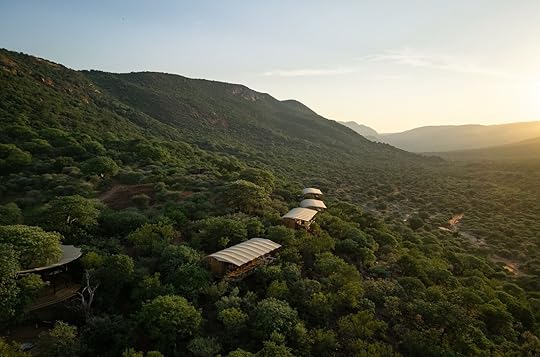
Do a quick search on Instagram or flip through any luxury travel publication, and you’ll see that an ultra-luxury safari is out of reach, unless you’re a wealthy traveler who can afford the daunting price tag.
Except — that’s no longer true, at least if you’re in the mood for a safari in South Africa’s Limpopo Province. It sits in the northernmost part of the country and is known for the northern section of Kruger National Park, as well as plenty of other game drive destinations. It’s there you’ll find Few & Far Luvhondo, a high-end and sustainable safari lodge inside Vhembe Biosphere Reserve. It recently put a new twist on luxury safari vacations: rather than paying $1,800 or more per night, just pay whatever you want.
The promotion lets guests set their own price for a stay in one of the resort’s six cabins. It’s called the “Nature Has No Price Tag” campaign and is designed to allow visitors who are interested in conservation, ecosystem revitalization, and transformative travel to experience the reserve, even if they don’t have the bank account to back it up. It’s also designed to show that ecosystems need more than money. “This place belongs to more than a few,” says the resort announcement. “Each guest contributes not just financially, but energetically—to a growing movement of people who care, protect, and return more than they take.”
View this post on InstagramA post shared by Few & Far Luvhondo (@fewandfar.luvhondo)
Prospective guests will need to fill out a short digital application to outline preferred dates, group size, motivation for visiting, and a proposed contribution. According to the resort, the intent is to shift the focus on South Africa’s wild lands away from just the financial bottom line to prioritize a shared responsibility in tourism and ecosystem preservation. Selection criteria are thus tied as much to applicants’ motivation and alignment with the lodge’s values as to financial capability. “The ‘why’ is especially important,” a resort representative told Matador Network via email, “as it helps the team understand each guest’s connection to the cause and ensures the experience aligns with shared values of conservation and purpose-driven travel.”
When an offer falls outside logistical boundaries, such as offering $200 for a week-long stay, the resort may reach out to suggest shortening the stay or contributing in another way. But there are technically no set boundaries on the proposed nightly rate or number of nights. Guests should choose dates as far in advance as possible to give the resort time to respond and plan. The proposed rate will cover the guests’ entire stay, including all meals, house activities, and guided excursions. Some activities have an extra fee, such as trips to see Samango monkeys in the surrounding mountains, or rides on the soon-to-open Solyrus cable car over the savanna.
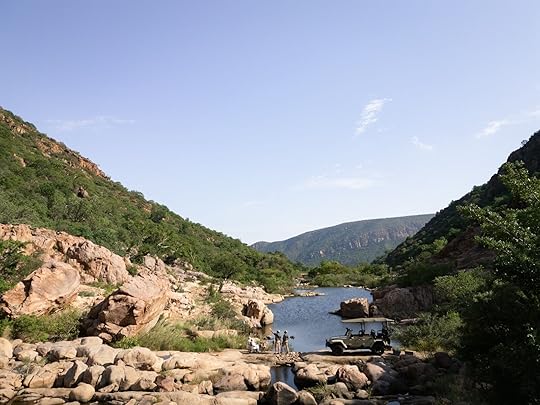
Photo: Few and Far Luvhondo
The best candidates for the promotion, which operates on a rolling basis with no fixed end date, will be those who share the lodge’s values. While Few & Far Luvhondo isn’t a non-profit, it employs a conservation-minded business model that supports ongoing restoration projects in the surrounding region. The hotel is owned by the founders of the US-based Under Canvas brand, and is the hub for a 50-year carbon-sequestering project designed to protect the mountains and restore their biodiversity. It actively practices rewilding, and partners with organizations like Panthera to monitor, track, and protect endangered leopards. The resort has opportunities for hands-on and observational conservation experiences, hires local craftsmen and artisans, and has programs for families and younger travelers via a Young Explorers program.

Photo: Luke Duncan/Shutterstock
The Vhembe Biosphere Reserve was officially designated by UNESCO in 2009 for its exceptional biodiversity and geological history. That includes the Soutpansberg Mountains, among the oldest in the world at two billion years old and home to more than 500 tree species. Few & Far Luvhondo is in the mountains on nearly 50,000 acres. Private game drives across the reserve are included for all guests, with species like leopards, impalas, kudus, giraffes, zebras, waterbucks, bushbabies, or African wildcats all living in the area. Guests can book day trips to Mapungubwe National Park to see Africa’s “Big 5,” or book activities like guided hikes or volunteering with a nearby conservation program. 
The Best Airbnbs Near Toronto’s BMO Field for Soccer Fans

Come summer 2026, six World Cup matches — including the Canadian Men’s National Team’s historic opener — will pack BMO Field with a roar you might hear echoing across Lake Ontario.
If you’re planning to be there in person, it pays to think ahead about where to stay. There’s a wide mix of Airbnbs within walking distance that feel more personal and comfortable than a standard hotel room. Toronto’s neighborhoods near BMO Field — Liberty Village, Parkdale, and the western waterfront — are filled with condos, townhouses, and lofts that put you steps from the stadium and within easy reach of the fan festival at Fort York.
To help you stay close to the action, here are the best Airbnbs near BMO Field, so you can focus on the matches — and maybe sneak in a waterfront walk or a late-night bite in Liberty Village.
Airbnbs within a 15-minute walk | 20–25-minute walk | 30–35-minute walkWe hope you love the Airbnbs near BMO Field we recommend! Just so you know, Matador may collect a small commission from the links on this page if you decide to book a stay. Listed prices are accurate as of the time of publication.
Traveling to Toronto for the World Cup? Check out Matador’s World Cup guides: The Best Soccer Bars in Toronto Where to Eat, Play, and Stay During the 2026 Toronto World Cup Games The Best Airbnbs in Downtown Toronto, From the Harbourfront to the CN Tower Sheraton Centre Toronto Hotel Is the Perfect Base For Exploring the City 8 Hotels in Toronto With Outstanding Service and Proximity to Must-See Attractions The Best Airbnbs in Downtown Toronto, From the Harbourfront to the CN TowerAirbnbs within a 15-minute walk of BMO FieldApartment for 6 with a balcony and rooftop pool
 Photo: Airbnb
Photo: Airbnb Photo: Airbnb
Photo: Airbnb Photo: Airbnb
Photo: Airbnb Photo: AirbnbSee more photos
Photo: AirbnbSee more photosDistance from BMO Field: 15-minute walk
Location: Liberty Village — steps from BMO Field, Exhibition Place, King StreetWho is this Airbnb for? Anyone from solo guests to families wanting a pro-managed rentalCapacity: Three-bedroom apartment for six guestsStandout amenities: Seasonal rooftop pool, balcony, gym, workspaceWhat reviews say: Guests love the bright interior and walkable locationPrice: $445 per night
Book NowCentral condo for 2 with a skyline balcony Photo: Airbnb
Photo: Airbnb Photo: Airbnb
Photo: Airbnb Photo: Airbnb
Photo: Airbnb Photo: AirbnbSee more photos
Photo: AirbnbSee more photosDistance from BMO Field: 15-minute walk
Location: Liberty Village — overlooking the park and steps to King Street, Queen Street, Lake Ontario, and BMO FieldWho is this Airbnb for? Travelers who want a quiet spot with easy access to waterfront trails, downtown nightlife, and stadium eventsCapacity: One-bedroom apartment for two guestsStandout amenities: Balcony with city and park views, garage parking, streaming TV, gym, in-unit laundryWhat reviews say: Guest Favorite, top 5 percent of Airbnbs for cleanliness, location, and communicationPrice: $162 per night
Book Now1-bedroom condo for 4 with rooftop patio and parking Photo: Airbnb
Photo: Airbnb Photo: Airbnb
Photo: Airbnb Photo: Airbnb
Photo: Airbnb Photo: AirbnbSee more photos
Photo: AirbnbSee more photosDistance from BMO Field: 15-minute walk
Location: Elm Grove Avenue — quiet neighborhood near Liberty Village and Queen StreetWho is this Airbnb for? Small groups or couples who want a peaceful base close to downtownCapacity: One-bedroom condo for four guestsStandout amenities: Private rooftop patio, parking, modern decorWhat reviews say: Guests love the calm location and easy transit accessPrice: $171 per night
Book NowAirbnbs within a 20–25-minute walk of BMO Field
Loft for 2 with balcony and free parking
 Photo: Airbnb
Photo: Airbnb Photo: Airbnb
Photo: Airbnb Photo: Airbnb
Photo: Airbnb Photo: Airbnb
Photo: AirbnbSee more photos
Distance from BMO Field: 20-minute walk
Location: King West near Liberty Village, Queen West, Trinity Bellwoods ParkWho is this Airbnb for? Couples or solo fans who want a bright, industrial-style, walkable spaceCapacity: One-bedroom loft for two guestsStandout amenities: Balcony, gym with Peloton, washer/dryer, record playerWhat reviews say: Top five percent for ratings, spotless interior, responsive hostingPrice: $250 per night
Book Now
2-bedroom townhouse with terrace and parking
 Photo: Airbnb
Photo: Airbnb Photo: Airbnb
Photo: Airbnb Photo: Airbnb
Photo: Airbnb Photo: Airbnb
Photo: AirbnbSee more photos
Distance from BMO Field: 20-minute walk
Location: Liberty Village — walking distance to CN Tower, waterfront, Exhibition PlaceWho is this Airbnb for? Small groups or families wanting extra spaceCapacity: Two-bedroom townhouse for four guestsStandout amenities: Rooftop terrace, chef’s kitchen, garage parkingWhat reviews say: High ratings for peaceful neighborhood and thoughtful decorPrice: $285 per night
Book Now
Townhome for 4 with rooftop terrace and CN Tower views
 Photo: Airbnb
Photo: Airbnb Photo: Airbnb
Photo: Airbnb Photo: Airbnb
Photo: Airbnb Photo: Airbnb
Photo: AirbnbSee more photos
Distance from BMO Field: 20-minute walk
Location: Liberty Village near Exhibition Place, Lake Ontario, downtownWho is this Airbnb for? Small groups or families wanting outdoor spaceCapacity: One-bedroom townhome for four guestsStandout amenities: Rooftop terrace with BBQ, mural art, parking, laundryWhat reviews say: Top 10 percent of listings; loved for rooftop views and cozy layoutPrice: $235 per night
Book Now
Bright heritage loft for 2 near BMO Field
 Photo: Airbnb
Photo: Airbnb Photo: Airbnb
Photo: Airbnb Photo: Airbnb
Photo: Airbnb Photo: Airbnb
Photo: AirbnbSee more photos
Distance from BMO Field: 25-minute walk
Location: King West near Queen Street, Liberty Village, Trinity Bellwoods ParkWho is this Airbnb for? Solo travelers or couples who love heritage detailsCapacity: Studio loft for two guestsStandout amenities: 13-foot ceilings, brick walls, dedicated workspaceWhat reviews say: Guests praise the relaxing atmosphere and historic charmPrice: $171 per night
Book Now
2-bedroom penthouse with rooftop patio and skyline views
 Photo: Airbnb
Photo: Airbnb Photo: Airbnb
Photo: Airbnb Photo: Airbnb
Photo: Airbnb Photo: Airbnb
Photo: AirbnbSee more photos
Distance from BMO Field: 20-minute walk
Location: Downtown — close to CN Tower, Rogers Centre, waterfrontWho is this Airbnb for? Small groups or families wanting panoramic viewsCapacity: Two-bedroom penthouse for five guestsStandout amenities: Private rooftop patio, floor-to-ceiling windows, gymWhat reviews say: Guests rave about the stunning views and bright interiorsPrice: $275 per night
Book Now
3-bedroom home with porch and spa bathroom
 Photo: Airbnb
Photo: Airbnb Photo: Airbnb
Photo: Airbnb Photo: Airbnb
Photo: Airbnb Photo: Airbnb
Photo: AirbnbSee more photos
Distance from BMO Field: 25-minute walk
Location: Queen West near Trinity Bellwoods Park, the Drake HotelWho is this Airbnb for? Groups or families wanting a spacious, character-filled homeCapacity: Three-bedroom house for six guestsStandout amenities: Outdoor porch, spa bathroom, fireplaceWhat reviews say: Guests love the artistic decor and roomy layoutPrice: $527 per night
Book Now Airbnbs within a 30–35-minute walk of BMO Field
Home for 8 with lakeview terrace and 4 ensuites
 Photo: Airbnb
Photo: Airbnb Photo: Airbnb
Photo: Airbnb Photo: Airbnb
Photo: Airbnb Photo: Airbnb
Photo: AirbnbSee more photos
Distance from BMO Field: 35-minute walk
Location: Little Tibet — near Sunnyside Beach, High Park, Queen Street WestWho is this Airbnb for? Groups wanting a high-end stay with lake views and ensuite bathsCapacity: Four-bedroom house for eight guestsStandout amenities: Lakeview terrace, soaking tub, multiple outdoor spaces, fireplaceWhat reviews say: Guests love the spacious bedrooms and upscale finishesPrice: $498 per night
Book Now
2-level loft for 6 with rooftop space
 Photo: Airbnb
Photo: Airbnb Photo: Airbnb
Photo: Airbnb Photo: Airbnb
Photo: Airbnb Photo: Airbnb
Photo: AirbnbSee more photos
Distance from BMO Field: 30-minute walk
Location: Queen West across from Trinity Bellwoods ParkWho is this Airbnb for? Groups or families who want design-forward space near nightlifeCapacity: Three-bedroom loft for six guestsStandout amenities: Rooftop terrace with CN Tower views, designer furnishings, Nespresso machineWhat reviews say: Top 10 pecent of Airbnbs; guests love park views and thoughtful designPrice: $302 per night
Book Now
Roomy townhouse for 6 with garden and bright sunroom
 Photo: Airbnb
Photo: Airbnb Photo: Airbnb
Photo: Airbnb Photo: Airbnb
Photo: Airbnb Photo: Airbnb
Photo: AirbnbSee more photos
Distance from BMO Field: 35-minute walk
Location: Queen West — near cafes, boutiques, Trinity Bellwoods ParkWho is this Airbnb for? Families or groups who want outdoor space and a creative layoutCapacity: Three-bedroom townhouse for six guestsStandout amenities: Sunroom overlooking garden, fenced backyard with BBQ, spacious dining areaWhat reviews say: Guests love the backyard oasis and unbeatable location
Price: $264 per night
Book NowMore like thisRestaurants + BarsThe 8 Best Soccer Bars in Toronto for Watching the World Cup
July 15, 2025
The Best Airbnbs Near Seattle’s Lumen Field for Soccer Fans

When the FIFA World Cup rolls into Seattle in 2026, the SoDo neighborhood around Lumen Field is going to go off. Six matches, including two knockout rounds and a crucial group-stage clash for the USMNT, will bring thousands of fans downtown. If you’re planning to be among them, it pays to think ahead about where to stay.
Airbnbs can offer more flexibility than a hotel, and some of these rentals are within a short walk of the stadium, so you can head straight to the match without worrying about a rideshare. Others farther north along the waterfront have balconies or rooftops where you can catch a sunset over the ocean. Whether you’re coming with a partner, the whole family, or a crew of friends, there’s a rental here that suits your needs. From smart studios in Pioneer Square to waterfront condos, these are the best Airbnbs near Lumen Field for soaking up every minute of World Cup fever.
We hope you love the Airbnbs near Lumen Field we recommend! Just so you know, Matador may collect a small commission from the links on this page if you decide to book a stay. Listed prices are accurate as of the time of publication.
Traveling to Seattle for the World Cup? Check out Matador’s World Cup guides: Where to Eat, Play, and Stay During the 2026 Seattle World Cup Matches The Best Hotels Near Seattle’s Lumen Field for Soccer Fans The 7 Best Soccer Bars in Seattle for Watching the World Cup The 7 Coolest Cannabis-Friendly Airbnbs in Seattle 13 Seattle Airbnbs Close To Fresh Seafood, Pike Place, and the Space Needle Airbnbs within a 15-minute walk of Lumen Field | Downtown and waterfront stays | Group-friendly homes near stadiumsAirbnbs within a 15-minute walk of Lumen FieldSuite for 2 in Pioneer Square with rooftop deck and water views Photo: Airbnb
Photo: Airbnb Photo: Airbnb
Photo: Airbnb Photo: Airbnb
Photo: Airbnb Photo: AirbnbSee more photos
Photo: AirbnbSee more photosDistance from Lumen Field: 10-minute walk
Location: Pioneer Square, steps from the waterfront, stadiums, and Seattle’s historic arts sceneWho is this Airbnb for? Couples or solo travelers seeking a stylish, walkable retreatCapacity: One-bedroom suite for two guests, one queen bed, one bathroomNoteworthy amenities: Private balcony with Puget Sound views, shared rooftop deck with BBQ, in-unit washer/dryer, air conditioning, gym accessWhat reviews say: Guests praise the clean, modern space and unbeatable walkability to stadiums and attractionsPrice: $271 per night
Book NowChic studio steps from Lumen Field with skyline terrace Photo: Airbnb
Photo: Airbnb Photo: Airbnb
Photo: Airbnb Photo: Airbnb
Photo: Airbnb Photo: AirbnbSee more photos
Photo: AirbnbSee more photosDistance from Lumen Field: Five-minute walk
Location: Pioneer Square, surrounded by cafes, art galleries, and Seattle’s historic architectureWho is this Airbnb for? Solo travelers or couples who want a modern, hotel-style stay in the heart of the cityCapacity: Studio loft for two guests, a queen lofted bed is accessible by ladderNoteworthy amenities: Rooftop terrace with skyline views, fully equipped kitchenette, contact-free check-in, luggage lockers, and dedicated workspaceWhat reviews say: Guests highlight the spotless interiors, secure building access, and great location close to stadiums and waterfront attractionsPrice: $243 per night
Book NowStudio for 4 with skyline vistas in Seattle’s historic district Photo: Airbnb
Photo: Airbnb Photo: Airbnb
Photo: Airbnb Photo: Airbnb
Photo: Airbnb Photo: AirbnbSee more photos
Photo: AirbnbSee more photosDistance from Lumen Field: Five-minute walk
Location: RailSpur building in Pioneer Square, close to the waterfront, stadiums, and art galleriesWho is this Airbnb for? Couples, solo travelers, or friends comfortable with a loft bed ladder and an urban vibeCapacity: Studio accommodating four guests, with a queen loft bed and a sofa bedNoteworthy amenities: Rooftop terrace, fully equipped kitchenette, luggage lockers, and contact-free check-inWhat reviews say: Guests praise the walkable location, clean, modern design, and 24/7 support teamPrice: $248 per night
Book NowCharming loft for 2 with soaring ceilings near Pike Place Photo: Airbnb
Photo: Airbnb Photo: Airbnb
Photo: Airbnb Photo: AirbnbSee more photos
Photo: AirbnbSee more photosDistance from Lumen Field: 10-minute walk
Location: Pioneer Square, Seattle’s historic district near top restaurants, art galleries, and nightlifeWho is this Airbnb for? Couples or solo travelers seeking a romantic or design-focused stayCapacity: Studio loft for two guests, one king bed, one bathroomNoteworthy amenities: 10-ft arched window with electronic shades, king canopy bed, in-unit washer/dryer, restaurant discountWhat reviews say: Guests rave about the perfect walkable location, beautiful historic space, and responsive hostPrice: $300 per night
Book NowBrick loft with vintage details and space for 3 guests Photo: Airbnb
Photo: Airbnb Photo: Airbnb
Photo: Airbnb Photo: Airbnb
Photo: Airbnb Photo: AirbnbSee more photos
Photo: AirbnbSee more photosDistance from Lumen Field: 10-minute walk
Location: Pioneer Square, surrounded by galleries, cafes, and Seattle’s historic architectureWho is this Airbnb for? Solo travelers, couples, or small groups seeking a unique space with vintage characterCapacity: Studio loft for three guests, one lofted queen bed and a full-size futonNoteworthy amenities: 14-foot ceilings, exposed brick walls, refinished wood floors, fully stocked kitchen, secure building with elevatorWhat reviews say: Guests love the spacious layout, walkability to stadiums and attractions, and thoughtful touches from the hostPrice: $181 per night
Book Now1-bedroom loft with exposed brick and beds for 4 guests Photo: Airbnb
Photo: Airbnb Photo: Airbnb
Photo: Airbnb Photo: AirbnbSee more photos
Photo: AirbnbSee more photosDistance from Lumen Field: 10-minute walk
Location: Pioneer Square, steps from the ferry terminal, cafes, galleries, and downtown attractionsWho is this Airbnb for? Adults looking for a stylish, urban escape with character and walkabilityCapacity: One-bedroom loft for four guests, three beds, one bathroomNoteworthy amenities: Exposed brick, high ceilings, vintage decor, fully equipped kitchen, robes, and self check-inWhat reviews say: Guests highlight the ideal location, spacious layout, and distinctive vintage atmosphere, perfect for exploring SeattlePrice: $208 per night
Book NowDowntown and waterfront staysWaterfront condo for 6 guests, with pool and panoramic views Photo: Airbnb
Photo: Airbnb Photo: Airbnb
Photo: Airbnb Photo: Airbnb
Photo: Airbnb Photo: AirbnbSee more photos
Photo: AirbnbSee more photosDistance from Lumen Field: 25-minute walk
Location: Downtown Seattle, directly above Pike Place Market, with sweeping views of the Puget Sound and Olympic MountainsWho is this Airbnb for? Families or groups seeking a high-end stay with resort-style amenities and incredible sceneryCapacity: Two-bedroom condo for six guests, one queen bed, two twin beds, and a sofa bedNoteworthy amenities: Indoor pool, sauna, hot tub, gym, private parking, motorized blackout blinds, luxury appliances, and 24/7 conciergeWhat reviews say: Guests rave about the jaw-dropping views, central location steps from Pike Place, and thoughtful hostingPrice: $501 per night
Book Now2-bedroom condo with balcony and sunset views over the Sound Photo: Airbnb
Photo: Airbnb Photo: Airbnb
Photo: Airbnb Photo: Airbnb
Photo: Airbnb Photo: AirbnbSee more photos
Photo: AirbnbSee more photosDistance from Lumen Field: 30-minute walk
Location: Seattle waterfront, steps to Pike Place Market, the Great Wheel, and ferry terminalsWho is this Airbnb for? Families or friends seeking luxury and walkable access to top attractionsCapacity: Two-bedroom condo for six guests, two king beds and a queen sofa bedNoteworthy amenities: Private balcony with sweeping Puget Sound views, two secure garage parking spaces, fireplace, soaking tub, and floor-to-ceiling windowsWhat reviews say: Guests love the stunning views, spacious layout, and peaceful atmosphere right on the waterfrontPrice: $634 per night
Book Now2-bedroom condo for small groups on the waterfront Photo: Airbnb
Photo: Airbnb Photo: Airbnb
Photo: Airbnb Photo: Airbnb
Photo: Airbnb Photo: AirbnbSee more photos
Photo: AirbnbSee more photosDistance from Lumen Field: 30-minute walk
Location: Seattle waterfront next to the Marriott, steps from Pike Place Market, the Aquarium, and the Great WheelWho is this Airbnb for? Families, or couples seeking a peaceful retreat with unbeatable water viewsCapacity: Two-bedroom condo for five guests, three beds, and two bathroomsNoteworthy amenities: Private balcony facing Elliott Bay, secure garage parking, electric fireplace, central air conditioning, and modern furnishingsWhat reviews say: Guests love the relaxing views, walkable location to top attractions, and responsive hostPrice: $560 per night
Book NowDowntown 1-bed condo with pool, gym, and free parking Photo: Airbnb
Photo: Airbnb Photo: Airbnb
Photo: Airbnb Photo: AirbnbSee more photos
Photo: AirbnbSee more photosDistance from Lumen Field: 25-minute walk
Location: Newmark Tower in central downtown, close to the waterfront promenade, the Seattle Art Museum, and shopsWho is this Airbnb for? Couples or solo travelers who want a secure, stylish base within walking distance of the stadiumCapacity: One-bedroom condo for two guests, one queen bed, one bathroomNoteworthy amenities: Free secure garage parking, indoor pool and sauna, gym, fireplace, and balcony with skyline viewsWhat reviews say: Guests highlight the spotless space, thoughtful tech touches like the heated bidet and latte machine, and the excellent host communicationPrice: $270 per night
Book NowGroup-friendly homes near stadiums4-bedroom Craftsman with skyline views and backyard games Photo: Airbnb
Photo: Airbnb Photo: Airbnb
Photo: Airbnb Photo: Airbnb
Photo: Airbnb Photo: AirbnbSee more photos
Photo: AirbnbSee more photosDistance from Lumen Field: 45-minute walk, five-minute drive
Location: Beacon Hill, a friendly residential neighborhood just south of downtown, close to parks, coffee shops, and light railWho is this Airbnb for? Larger groups and families seeking a comfortable home base with plenty of room to relax togetherCapacity: Four-bedroom house for up to 13 guests, with multiple beds and spacious living areasNoteworthy amenities: Panoramic views of Puget Sound and the stadiums, backyard with bocce court, dedicated workspace, board gamesWhat reviews say: Guests highlight the peaceful location, beautiful interior updates, and accommodating hostsPrice: $337 per night
Book NowSpacious farmhouse for up to 16 guests with 8 bedrooms Photo: Airbnb
Photo: Airbnb Photo: Airbnb
Photo: Airbnb Photo: Airbnb
Photo: Airbnb Photo: AirbnbSee more photos
Photo: AirbnbSee more photosDistance from Lumen Field: 45-minute walk, five-minute drive
Location: Beacon Hill, under 10 minutes to downtown and the stadiums, walking distance to the light railWho is this Airbnb for? Large groups and families who want space to spread out, cook together, and enjoy sunset viewsCapacity: Up to 16 guests, eight bedrooms, multiple bathrooms, plus a separate garden-level suiteNoteworthy amenities: Expansive decks with panoramic city and water views, luxury kitchen, private driveway parking, central air, and a dedicated play area for kidsWhat reviews say: Guests rave about the incredible space for gatherings and easy access to stadiums, light rail, and Beacon Hill’s restaurantsPrice: $1,030 per night
Book NowPet-friendly 5-bedroom townhouse with rooftop Photo: Airbnb
Photo: Airbnb Photo: Airbnb
Photo: Airbnb Photo: Airbnb
Photo: Airbnb Photo: AirbnbSee more photos
Photo: AirbnbSee more photosDistance from Lumen Field: 30-minute walk, 10-minute drive
Location: Vibrant neighborhood between Downtown and Capitol Hill, surrounded by cafes, restaurants, and nightlifeWho is this Airbnb for? Groups or families who want modern design, great walkability, and plenty of room to gatherCapacity: Five bedrooms for up to 12 guests (four queen beds, twin bunks, plus air mattress on request)Noteworthy amenities: Rooftop deck with skyline views, fully stocked kitchen, spa-style main bathroom, pet-friendly policy, and free off-street parkingWhat reviews say: Guests love the spacious layout, easy walk to shops and dining, and welcoming host
Price: $441 per night
Book NowMore like thisTravelThe 9 Best Soccer Bars in Dallas for Watching the World CupI Tested Ibex’s Merino Wool Underwear and It Passed With Flying Colors, Even During a Heat Wave

My fascination with merino wool did not start with products. It started with a weekend in a family–owned wool farm outside of Melbourne, Australia. A friend was studying factors influencing wool quality, and she needed help with shearing about 200 sheep while also collecting merino wool samples for her research. It was hard work, well rewarded by homemade meals and one of the most interesting experiences with animals of my life. I could see how sheep were treated ethically and were very well-cared-for by the family. Many of the sheep had proper names and the family knew their personalities well. Most of the time, the sheep just wandered across large swaths of land, minding their own business. The shearing process, which took place twice a year, was designed to disturb the animals as little as possible.
Now, why merino wool underwear? I had heard from my colleagues that merino shirts stayed “clean” after wearing them for 12 days while traveling, and that Ibex Merino wool outdoor clothing was some of the best in the market and basically never stank – even after extensive outdoor recreating and long travel days. So when I learned that Ibex made merino wool underwear, I got extremely curious. Would it actually be odorless? Would it be itchy? How would it perform on cold and hot days? Here is my experience testing both the Natural Thong ($30) and Natural Bikini bottom ($35), plus the Essentials Racerback ($65) and Cami ($60) shirts, in the Patagonian winter and the European summer (including a heat wave in Madrid).
We hope you love Ibex merino wool underwear! Just so you know, Matador may collect a small commission from the links on this page if you decide to make a purchase.
Is merino wool underwear itchy?
I found Ibex’s merino wool thong to be soft and not itchy at all. Photo: Debbie Gonzalez Canada
This was my very first concern, because I have sensitive skin and regular wool can be itchy for me. In my experience, Ibex’s merino wool underwear was never itchy, regardless of the weather, the layers of clothing I had, or the activities I was engaged in. The fabric felt as soft as cotton on my skin. Friends who tried other brands of merino wool did tell me they found it itchy, so bear that in mind: the brand does matter here.
The odorless promise (how long you can wear the underwear and the shirts)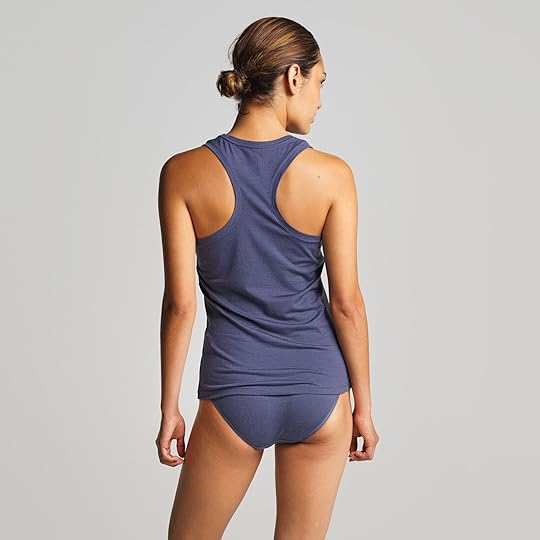
The Ibex Racerback shirt is ideal for long travel days. Photo: Ibex
Ibex’s bikini/thong and racerback/cami claim to be breathable and help with odor control, thermal regulation, and moisture-wicking. My experience with the products supports these claims, even under the recent European heat wave, making the price tag of merino wool underwear worth it.
In terms of odor control, the underwear and shirts perform as well as cotton, but they are better than cotton when it comes to moisture-wicking and breathability. No, I didn’t wear the underwear for 12 days like my colleague did with his merino shirt, but I could easily wear my racerback and the cami shirts for a week or more, if I have to. I do prefer to wear the merino wool bikini and thong for a normal period of time over other, more artificial fabrics (note, however, that the underwear is 83% merino wool, but it includes a bit of nylon and elastane for a tight fit).
The choice between bikinis and thongs is a personal one, and I found both to be comfortable, true to size and form-fitting. In terms of colors, I got the anthracite bikini and cami shirt (anthracite is a purple-grey-blue shade), a silver grey thong, and a black racerback, and I loved all of them. When I sweated with the shirts, though they dried quickly, the sweat was visible with the anthracite color, but not with the black racerback. The final test was that I took a Lindy Hop dance class on a summer day in Madrid, and the black racerback didn’t stink and didn’t show any sign of sweating.
How sustainable is Ibex’s merino wool? And how to make it last longer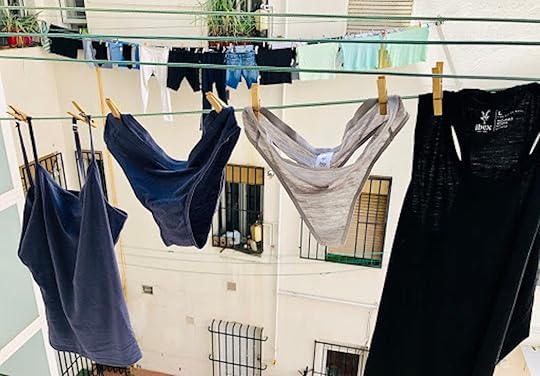
Hanging merino wool products in a line, Spanish style. Photo: Debbie Gonzalez Canada
I care deeply about sustainability and animal welfare. I had the opportunity to ask people at Ibex about this topic, and they assured me that they work hard on what they call “No-Bullshit Sustainability.” That extends to Ibex’s textile sourcing from Australia and New Zealand, where animal welfare has high standards, which coincides with my own experience in the Australian sheep farm. Ibex is also conscious about packaging choices, shipping methodologies, and scientifically-led carbon-offsets, among other efforts.
Plus, there’s the sustainability of the material itself, which is made to be durable, but when the end comes… merino wool is fully backyard compostable! This is important, as textile waste is a huge issue around the world.
Speaking of making it durable, here go a few recommendations to make your merino wool products last:
How to wash merino wool:
Following Ibex’s instructions, merino wool can be washed on a normal warm or cool machine cycle with regular detergent. Interestingly, the brand says that “Hand washing can enable a residual build-up of perspiration which could contribute to an odor problem” (plus, I despise having to hand wash stuff).It is important to avoid using softeners and bleach. The softener is the enemy of any piece of clothing that has a stretchy quality.Also, do not tumble dry the items. Even inside and in the shade, the underwear and shirts dried quickly every time I washed them.There is no need to iron the items, and it is actually better not to do that.Does merino wool shrink? I didn’t notice any shrinking, but I followed the washing instructions, and so should you to make the products last.
Is Ibex merino wool underwear worth it?
The writer would wear the Ibex Cami for a week straight – if she had to. Photo: Ibex
Though Ibex’s merino wool underwear and shirts can be more expensive than similar products in cotton and other fabrics, I found them to be worth the price tag because of the thermal regulation and moisture-wicking properties (which is a lot of jargon to say, you want your underwear dry when you are outdoors and exercising). To make your money and the natural resources count, make sure you follow the care instructions. 
Shop Ibex Essentials Racerback
More like thisOutdoorWe Tested Patagonia Rain Jackets in the Real World and These Are the 6 BestThis Popular Island Introduced a GPS That Won’t Tell You Where You’re Going
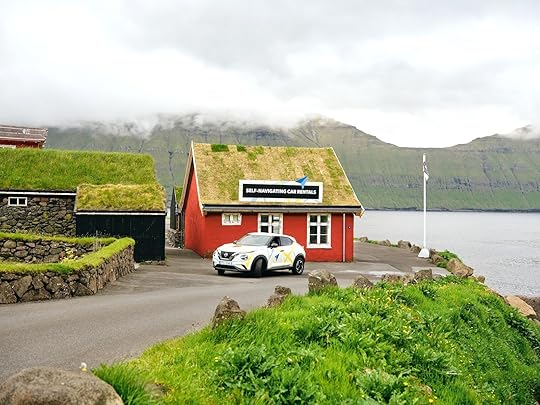
In an age when travel experiences are increasingly shaped by social media loops and TikTok influencers, the Faroe Islands just introduced a program going entirely in the opposite direction. The island group between Iceland and Norway just launched “Auto Odyssey” — a high-tech program that asks visitors to be completely removed from the itinerary process.
The new program includes a series of preset, self-navigating (not self-driving) car rentals available to guests. The twist is that the destinations are entirely secret. Rather than planning every stop in advance, travelers opt into one of 30 pre-programmed, self-guided road trips, and they won’t know where they’re headed until they get there. Navigation is activated via a QR code, with directions appearing on the traveler’s phone one segment at a time. Each trip lasts between three and six hours and stops at as many destinations, each recommended and curated by locals.
What’s even more noteworthy is what the program can promise to travelers: they’ll probably have the site to themselves. While there could be other random tourists who drove themselves there, the “Auto Odyssey” cars are programmed not to assign the same itinerary simultaneously, meaning you won’t have any other Auto Odyssey guests there while you are. It creates a better travel experience for guests, and helps the islands fight overtourism at its most fragile sites.
Addressing overtourism at the edge of Europe
Mulafossur waterfall is hardly the only gorgeous spot on the islands. Photo: Kotenko Oleksandr/Shutterstock
The Faroe Islands are home to around 55,000 residents, and have long attracted those seeking elemental beauty and isolation. But overtourism has been a growing problem — so much so that it’s closed to tourism in the past — thanks to Insta-famous images of places like Mulafossur Waterfall, Mykines Island, and Sørvágsvatn. Most of the islands’ arrivals are heading to just a handful of hotspots, leading to strains on local communities and a loss of solitude and quiet.
Auto Odyssey’s Faroe Island road trips instead send visitors away from the usual sites. The destinations tend to favor lesser-known villages, hidden valleys, and vistas that rarely appear in itineraries or social feeds. No route is published. According to Marta Káradóttir, Content and Communications Manager at Visit Faroe Islands, the program is designed to bring back some of the spontaneity of travel. “We’re really just asking travelers to let go of control for a moment,” she noted in the program announcement. “When you don’t know what’s around the next corner, you open yourself up to something completely different.”
How to book your Faroe Islands road trip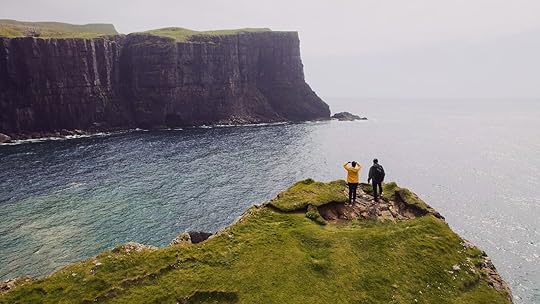
Photo: Visit Faroe Islands
The destinations along each Auto Odyssey route range from isolated turf-roofed churches to remote fjords, outdoor recreation opportunities, and local fish-and-chips spots. Local stories are shared at every location via the navigation system, and everything is done in your phone’s browser, no app required. You can do one trip per day, and rent the car for as many days as you’d like.
The program is run in partnership with local rental company 62N. Rates start at approximately $100–$103 per day, which is in line with rental prices on the island. The Auto Odyssey program is a free add-on you can choose when booking your rental. There’s just one rule: visitors must commit to completing the route without diverting to the typical tourist checklist. The experience relies on an honor system rather than physical enforcement, but following the route is key to ensuring that no guests arrive at the same place at the same time. 
This Kauaʻi Food Fest Will Make You Rethink What You Know About Poke

What is poke? If you live anywhere in mainland America, you might know it like I did, as a sort of gloopy but delicious raw fish dish, typically accompanied by rice, greens, avocado, edamame, and whatever other ingredients you might find in a grocery store sushi roll. If you’re native Hawaiian, though, you know poke for what it truly is: an elegant, fresh, and exceptionally local dish, most often made with cubes of local fish — the word “poke” essentially means “cut into chunks” in Hawaiian.

Photo: Maridav/Shutterstock
Enjoyed in Hawaiʻi for centuries, poke has changed as the islands have changed. Originally, poke was served as a means to an end, with fishermen tossing the leftover cuts of their daily catch with sea salt, inamona (candlenut seeds), and maybe some dried fish blood or limu (seaweed.) As Hawaiʻi opened up and other cultures descended on the islands, it started to absorb flavors and ingredients from other lands, like Spanish onions, Chinese oyster sauce, Japanese shoyu soy sauce, and Korean sesame seeds. A comfort food to many Hawaiians, poke has now become as varied and diverse as the Hawaiian people themselves.
Take, for instance, the 20-odd pokes on offer at the Kauaʻi Poke Fest in June at the Koloa Landing Resort. Running the gamut from extremely traditional to extremely out there, the pokes were created by local chefs, fisherpeople, and even lifeguards, all looking to catch the eye (and taste buds) of judges like “godfather of poke” Sam Choy and Top Chef Seattle finalist Sheldon Simeon.
Kicking off Friday in view of the ocean, among swaying palm trees and joyful yelps from what’s been dubbed “the best pool in America,” the 5th annual Kauaʻi Poke Fest featured not only the marquee poke competition but also a Poke Masters’ Table dinner, which found Choy, Simeon, and Chefs Don Gusman, Ronnie Rainwater, Wendy Leanio, and Ryan Alicante exploring not just poke but also the depth and richness of traditional Hawaiian ingredients. Simeon’s dish, for instance, featured a beautifully cooked piece of fish surrounded by a buttery sauce made with Haam Ning Mung, or salted roof lemons. Leanio and Alicante’s dessert was a cheesecake made with local purple sweet potatoes and accented with haupia, or a kind of coconut-milk-based custard.

Photo: Marah Eakin
For a mainlander like me, the dinner was eye-opening not just because of how delicious it was but also because of how educational it was. I grew up in a restaurant family, with a food writer for a mom, and I’ve eaten my way around the world. Even so, I came away from the Poke Masters dinner not just stuffed but also fervently impressed with the breadth of Hawaiian ingredients. Each chef talked so reverently about their ingredients, whether it was locally farmed shrimp or humble sea salt, that the dinner felt like as much of a tribute as it was a meal. I thought I knew food, but I got schooled in the very best way that night, and I left the event committed to spreading the gospel of Hawaiian cuisine.
That commitment was only deepened the next night at the Poke Fest as I paraded the resort’s ballroom, lei around my neck. Coming from the dinner the night before, and two afternoons at the hotel pool swimming and scarfing down some truly excellent poke from the resort’s Holoholo Grill, I thought I knew the poke basics, but the variety and diversity of what was in the room was staggering. I went back for seconds and thirds of Chef Gusman’s Paniolo Poke Ahi Chowder, which paid tribute not only to the fresh local fish but also to the paniolos, or Hawaiian cowboys, who wrangled cattle across the island for centuries. A perfect marriage of dried and fresh ahi, jalapenos, ulu yams, bacon, and onions, the chowder was served with a tortilla chip, paying tribute to the Mexican vaqueros (cattle ranchers) who were once invited to the islands to share their skills.

Photos: Marah Eakin
I went back for seconds of Lawaiʻa Fish Company’s offering, too, which ended up taking third place in the contest. Dubbed Da Krazy Asian Poke, the deceptively simple preparation also tipped its hat to Hawaiʻi’s history and people, including ingredients from all the cultures who’ve come to make the islands their transplanted home. Kristy Kahananui, who created the dish, told me that she wanted to focus on the fish in the dish, keeping it “not too fancy” and without “too much stuff,” but that she felt like her dish really benefited from both the inclusion of green papaya and a friend’s chili lime sauce, which she thought gave the poke just the right amount of heat.
The other two winners — Kauai Shrimp’s Torched Kauai Shrimp and Da Reel Kapakahi Red Eye’s Reel ‘Em & Feel ‘Em — were bangers, as well, showcasing sweet local shrimp and roasted inamona made with smoked meat drippings, respectively. Each dish paid tribute to its ingredients with honor and respect, proving how fresh and lively local Hawaiian ingredients can taste.
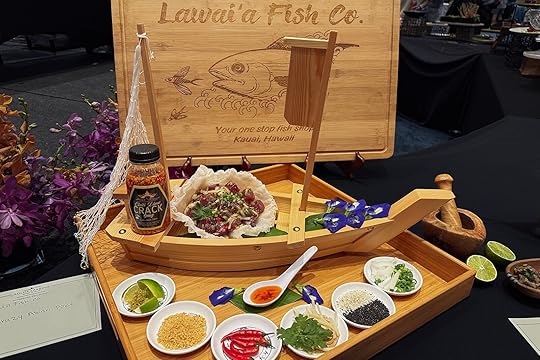
Photo: Marah Eakin
Stuffed to the proverbial gills with poke, I grabbed a beer, watched the band play, and kicked back on a couch just outside the resort’s airy main lobby. I might have been a newcomer to Kauaʻi when I first arrived, but I knew I was leaving a disciple, ready to spread the gospel of that place — and that excellent, mind-bending food — to everyone I know for as long as they let me. 
Matador Network's Blog
- Matador Network's profile
- 6 followers



